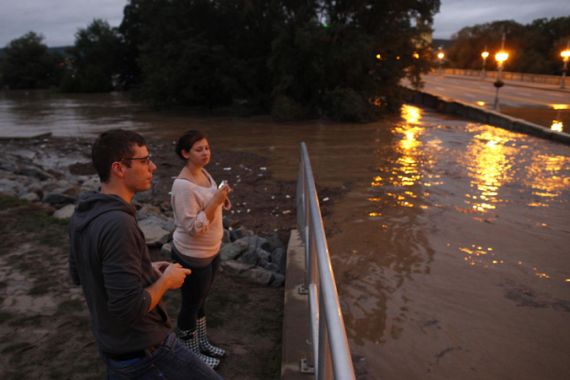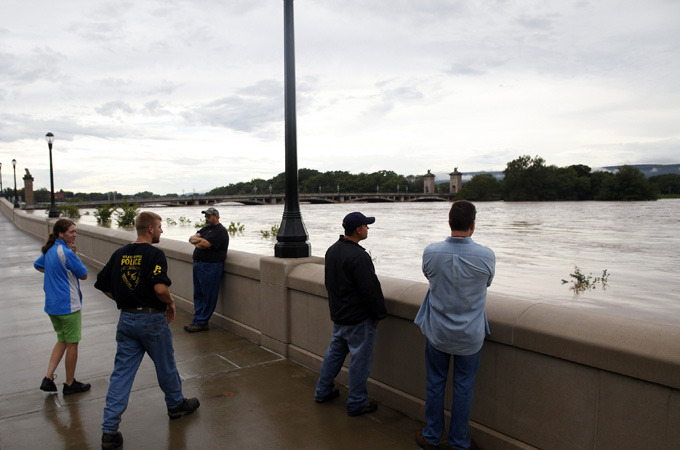Toxic floods hit US northeast coast
Sewage-tainted flood waters threaten public health, officials warn, after five killed in deluge.

 |
| City personnel monitor the Susquehanna River after flooding caused 65,000 people to evacuate [Reuters] |
Relentless rain has caused catastrophic flooding in the eastern United States, killing at least five people and forcing the evacuation of more than 130,000 in three states.
Remnants of Tropical Storm Lee swamped homes and businesses from Maryland to New England on Thursday and dropped up to 30cm of rain outside Harrisburg, Pennsylvania, which declared a state of emergency.
Keep reading
list of 4 itemsCould shipping containers be the answer to Ghana’s housing crisis?
Thousands protest against over-tourism in Spain’s Canary Islands
Holding Up the Sky: Saving the Indigenous Yanomami tribe in Brazil’s Amazon
Floodwaters are now polluted with sewage and other toxins and officials warn that public health in parts of the northeastern US could be at risk from direct exposure or contaminated private water wells.
Flood warnings were in effect in northern Virginia, Delaware, Maryland and upstate New York, and flood watches were under way in other areas from Massachusetts to Washington DC, according to the National Weather Service.
In Vermont, a dozen towns flooded by Irene are still on boil-water orders 12 days later, though no waterborne illness has been reported. Similar precautions have been taken in other storm-damaged states.
Vermont’s state health department is giving away free test kits so residents can check their wells for bacteria.
Al Jazeera’s senior meteorologist, Steff Gaulter says that despite the intense activity the hurricane season is not over yet.
“The Atlantic hurricane season lasts until the end of November, so there’s plenty of time for yet more storms to strike the US and cause yet more flooding.
“Part of the reason for this active season was due to La Nina that we had been experiencing in the Pacific Ocean. It was thought that La Nina was over until at least March next year, but we’ve just seen it return, and they’re now expected to get stronger over the next few months.
“This could well mean that the Atlantic Hurricane Season is even more active than previously thought,” Gaulter said.
Mass evacuation
In Pennsylvania, the rising waters of the Susquehanna River submerged picturesque towns like Tunkhannock and Shickshinny and forced the evacuation of 65,000 people from Wilkes-Barre and another 35,000 from surrounding counties, said Stephen Urban, commissioner of Luzerne County.
The typically meandering river was turned into a roiling toxic mess after washing out 10 sewage processing plants, Tom Corbett, the governor of Pennsylvania, said.
“We’re worried about people even getting near the water,” Corbett told a news conference.
The river was expected to crest at more than 12 metres on Friday, just short of levels that the Wilkes-Barre levees were built to withstand.
Authorities imposed a curfew in cities along the surging river. “After 8 o’clock, we’ll start arresting anyone who stays in this area,” a patrolman shouted over a bullhorn as police cars cruised Wilkes-Barre.
In Lancaster County, a 62-year-old woman in her car was caught in flood waters, and a man was swept away as he tried to walk through rushing water, authorities said.
In Virginia’s Fairfax County, flash floods swept away a 12-year-old boy in his family’s garden and a man in his sixties who was outside his car, said Lucy Caldwell, spokeswoman for Fairfax County Police.
In the Philadelphia area, mud and rock slides closed the region’s busiest commuter routes, such as the Schuylkill Expressway and US Route 1, as well as railways including four heavily travelled commuter lines.
Among New Jersey roads closed were busy Route 73 and parts of Route 29 in Trenton along the banks of the Delaware River.
In New York, Amtrak shut rail service west of Albany and officials expected many closures on the New York State Thruway.